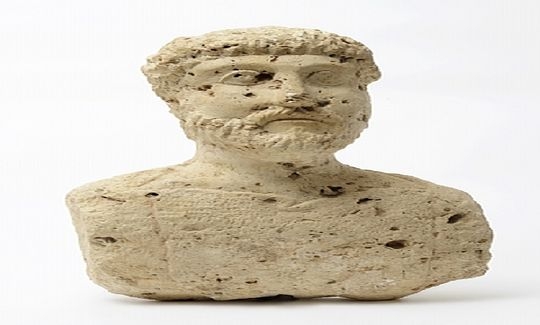Funerary Busts of the Roman Period in Eretz-Israel
Saturday, 24.03.12
:
Avshalom Zemer
More info:
046030800Stone funerary busts (protomae) of men and women of various ages appeared in Eretz-Israel during the Late Roman era (2nd-3rd centuries CE). In most cases the depiction is schematic, although in some there has been an attempt to create a likeness. Some of these works also carry names, of Greek, Latin, or Semitic origin, and even the age of the deceased. However, this does not reveal the ethnic identity of the dead because, at that time, it was the general custom to give Greek or Latin names.
These carved likenesses of the dead, including their clothing and hairstyles, display the styles that prevailed mainly in the eastern provinces of the Roman Empire. After the conquest of Eretz-Israel by Alexander of Macedon in 332 BCE, Graeco-oriental (Hellenistic) styles became customary among the population, particularly in the Hellenistic cities. Men and women alike are usually depicted wearing tunics, often with a covering garment. The women's hair is dressed in a variety of styles, sometimes embellished with jewellery. The men's hair is simpler, short or full, sometimes with a beard and/or a moustache.
About 200 of these busts are today located in museums and private collections throughout the world. Most of them were retrieved by the authorities from grave robbers, or acquired in the antique markets, so that their actual provenance is unknown. From archaeological excavations in Beth-Shean and at Sebastia in Samaria, such images have been found in tombs constructed or hollowed out of the rock. These burials were usually those of the elite, as were the busts themselves, since only persons of wealth could afford them.
In Eretz-Israel, the custom was limited to two cities - Skythopolis (Beth-Shean) and Sebaste (Sebastia). Most of the busts were found in the environs of Beth-Shean, and analysis of their styles suggests that there were several workshops in the area. The earliest are dated to the end of the reign of Trajan (98-117 CE) and the beginning of Hadrian's rule (117-138 CE). It seems that, in the mid-3rd century CE, the lower classes of Skythopolis also adopted this custom, which probably accounts for the poor workmanship that was obviously cheaper. This was apparently due to a law enforced by the Emperor Antoninus Caracalla (211-217 CE), according to which all inhabitants of all parts of the Empire were to be recognized as Roman citizens with equal rights - known as the Constitutio Antoniniana. Only a few workshops continued to function after the reign of Caracalla, and by the 4th century funerary busts of this type were no longer being made.
The subjects are of all ages - from children to the elderly. They embody the work of local craftsmen who lacked the skills of the Roman portrait sculptors, and were created according to two sculptural traditions - Roman and oriental. Both styles also show a Hellenistic influence.
The Roman type derives from the Roman memorial portraits of family ancestors, and the influence of the imperial portrait busts is evident. The oriental type essentially displays elements of Nabatean art, and is seen mainly in the funerary busts of Sebastia. (The Nabateans were Arabian tribes who dwelled in the deserts of Eretz-Israel and Transjordan, and existed as early as the 4th century BCE). The Hellenistic influence is evidence of a Graeco-oriental population in northern Eretz-Israel at that time. The schematic representation of various details suggests that the craftsmen were not attempting to produce lifelike portraits, but rather to create a resemblance that would satisfy the client. The formal and artistic resemblance between the busts also suggests that the local craftsmen influenced each other. The busts from the end of the 3rd century CE show a decline in artistry, expressed in generalization and standardization. It seems that the disappearance of the funerary busts in the 4th century CE is also connected with the spread of Christianity as the foremost religion in our region in 324 CE.
The exhibition is based on the collection of Dr. Alexander Roche, founder and first director of the Museum of Ancient Art in Haifa, which was integrated with the National Maritime Museum in 1995.

